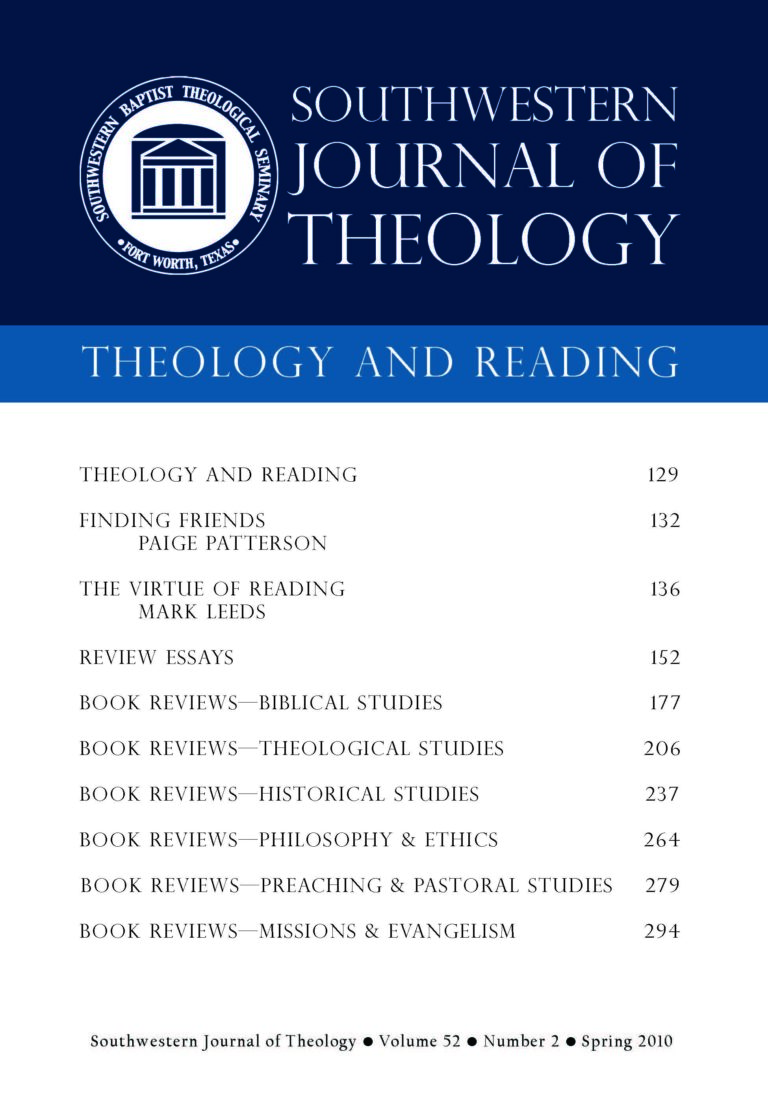
Theology and Reading
Southwestern Journal of Theology
Volume 52, No. 2 – Spring 2010
Managing Editor: Malcolm B. Yarnell III
By Michael S. Horton. Louisville: Westminster John Knox, 2007. 324 pages. Softcover, $34.95.
While Horton claims that his “primary goal . . . is not to exonerate the tradition, but to interact with the New Perspective on Paul (NPP) from within it” (12), his two-part work still reads as a defense of the traditional doctrine of grace-based forensic justification by imputation against both the recent proposals of the NPP and Radical Orthodoxy (RO). He characterizes the NPP as having a works-based justification and the RO, similar to Osiander, as stressing infusion (transformative ontic participation) through mystical union with Christ (130). Horton’s work is the third volume of a planned four-part series.
In the first part, Horton claims that one’s view of justification is dependent upon how one views the relationship between the covenants. He argues that because the NPP ( James D.G. Dunn, E.P. Sanders, and N.T. Wright) views the new covenant (Lk 22:20) as “the renewal of the Sinai covenant” (84), its failure to maintain the distinction between the suzerainty (law-Sinai) and royal grant (promise-Zion) covenants (29) leads to the view of “covenantal nomism.” He interprets Sanders’ “covenantal nomism” to mean that covenant refers to “grace” and nomism refers to “law” resulting in a monocovenantal “pattern of religion” characterized by “gracious law” (39) in “which one gets in by grace, but remains in by obedience” (37). Horton’s distinction between the covenants is maintained when their relationship is conceived of as the law of the old covenant (2 Cor 3:14) being fulfilled in the new covenant (24) so that law no longer functions as “the principle or basis for punishment and reward . . . [but] as a normative guide that is no longer able to condemn” (87). According to Horton, this distinction and relationship between the covenants leads to the basis of justification being grace alone (21) while in the NPP it leads to “faithfulness—our own covenantal obedience” (107).
In the second part, Horton claims that one’s view of union with Christ and its relation to justification is dependent on metaphysical presuppositions. He argues for forensic justification by imputation as the basis for a transformative union of incorporation through Christ’s federal headship (168) and corporate solidarity (Rom 5:12–21) (186) as opposed to the neoplatonic views of participation or mystical union by infusion of divine essence advocated by RO ( John Milbank) and the New Finnish-Helsinki School (Tuomo Mannermaa and Robert Jenson) (159). He states that RO’s metaphysical view of metathexis—ontological participation of the natural in the supernatural (157)—creates a matter-spirit dualism (207) in which matter is dependent on spirit (God’s essence). He asserts that this metathexis is inconsistent with the biblical view of a creature-creator dualism, in which, using Gregory Palamas’ language, the creature is dependent on the creator’s energies not essence (164). As he “follows the ordo in Romans 8:30 . . . as a general rubric” (267), he argues that as later Reformed theology defended against synergism, it differentiated between regeneration and effectual calling. This differentiation involved “an infusion of a new habitus (disposition) prior to effectual calling” which resulted in a mixed biblical and neoplatonic metaphysics in the ordo (216). He eliminates the neoplatonic-infused habitus from the ordo by using Vanhoozer’s speech act theory instead of an Aristotelian causality as a descriptive scheme to identify effectual calling with regeneration (240). Once grace is no longer a substance infused (168), “transforming the natural into the supernatural” (254), but rather “God’s favor on account of Christ” (168), “restoring rather than transcending created nature” (189), then justification is seen as the source rather than the result of sanctification and glorification (244).
Horton’s summaries of both the NPP and RO serve as a good introduction for readers who are not familiar with these views and a good review for those who are familiar. Because Horton clearly indicates that he is writing from a Reformed perspective, readers who are of a different tradition or theological perspective may be uncomfortable with the covenantal theological emphasis in his arguments: spiritualization of Israel (47), tripartite division of the law (66–67), function of the law (87), use of the pactum salutis (131), and view of the relationship of theology and philosophy (182). Despite potential discomfort, any reader will benefit from Horton’s insightful criticism of the NPP and RO as well as his helpful corrective proposals. While Horton is likely correct that the NPP’s position, both logically and theologically, rests largely on its view of the relationship of the covenants, it would be an overstatement if he were suggesting that its view rests on this covenant factor alone. Other factors certainly contribute to and sustain the formation and foundation of the NPP’s view. Readers suspicious of speech act theory will certainly be wary of Horton’s use of it in reordering the ordo.





